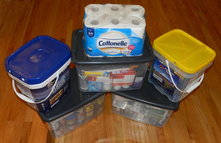Disaster Preparedness
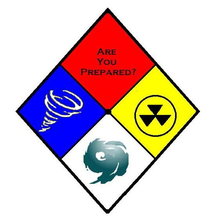
Every year there are tornadoes, hurricanes, cyclones, floods, snow storms, earthquakes, wildfires, tsunamis, storm surges, volcanic eruptions, viruses, disease epidemics/pandemics (like COVID-19 - the coronavirus), insect/animal plagues and other unanticipated disasters that cause people to live without power, water, new food supplies, heating/air conditioning and immediate medical assistance for extended periods of time, or cause people to have to evacuate their homes.
Although Disaster Preparedness is not Hiking, Camping or Shooting – there’s a great deal of overlap regarding the gear; especially if the disaster lasts more than a couple of days – so we decided to include some information about it on our website.
Luckily all of the gear that you already have for your Hiking and Camping adventures can be used to help mitigate the problems caused by disasters. But there are also some other items that you might want to have on hand just in case the situation lasts for days (plan for at least 3 days - 72 hours), a week, or more (two weeks if you can); whether you are at your home or forced to temporarily relocate.
Although Disaster Preparedness is not Hiking, Camping or Shooting – there’s a great deal of overlap regarding the gear; especially if the disaster lasts more than a couple of days – so we decided to include some information about it on our website.
Luckily all of the gear that you already have for your Hiking and Camping adventures can be used to help mitigate the problems caused by disasters. But there are also some other items that you might want to have on hand just in case the situation lasts for days (plan for at least 3 days - 72 hours), a week, or more (two weeks if you can); whether you are at your home or forced to temporarily relocate.
The main thing that you need to think about when collecting your Disaster Preparedness gear is the “Rule of 3”. This rule states that you can survive for 3 minutes without air/oxygen or in icy water. You can survive for 3 hours without shelter in a harsh environment. You can survive for 3 days without water (if sheltered from a harsh environment). You can survive for 3 weeks without food (if you have water and shelter).
Your Disaster Preparedness kit shouldn’t cost you that much since you’re really just augmenting the Hiking, Camping and Shooting equipment that you already have. You might even currently have some of our recommended items in your house. You should probably plan on spending between $500 and $750 to purchase what we’ve recommended (with the largest cost items being the medical supplies – especially if you purchase antibiotics - food and safety/repair items). But you don’t need to buy everything all at once. Plan ahead and buy a little at a time – perhaps in the priority order shown below (e.g. water, food, cleanliness, First Aid, respiratory protection, safety & repairs, storage bins) – so that you can catch the items when they are on sale.
Remember, you really need to plan ahead and have these items safely tucked away in your house before a disaster hits and they are scarce, or impossible, to find. Purchasing the items before there is any trouble means that you can easily find them in your local stores, or get them shipped directly to your home in a few days from Amazon. Conversely, once a disaster strikes it will probably be too late.
Your Disaster Preparedness kit shouldn’t cost you that much since you’re really just augmenting the Hiking, Camping and Shooting equipment that you already have. You might even currently have some of our recommended items in your house. You should probably plan on spending between $500 and $750 to purchase what we’ve recommended (with the largest cost items being the medical supplies – especially if you purchase antibiotics - food and safety/repair items). But you don’t need to buy everything all at once. Plan ahead and buy a little at a time – perhaps in the priority order shown below (e.g. water, food, cleanliness, First Aid, respiratory protection, safety & repairs, storage bins) – so that you can catch the items when they are on sale.
Remember, you really need to plan ahead and have these items safely tucked away in your house before a disaster hits and they are scarce, or impossible, to find. Purchasing the items before there is any trouble means that you can easily find them in your local stores, or get them shipped directly to your home in a few days from Amazon. Conversely, once a disaster strikes it will probably be too late.
Here's the type of Disaster Preparedness gear (in addition to all of the other Hiking, Camping and Shooting gear) that we think you need to have on hand to be ready when a disaster hits your area:
- Water
- Non-perishable Food
- Personal Cleanliness Items
- First Aid Kit Additions
- Respiratory Protection
- Safety and Repairs
- Cash
- Critical Information Packet
- Plastic Storage Bins
- Note: click on any photo to enlarge it
Water

Water is critical for survival. Unfortunately, in a disaster water lines can break and water pumps can fail - leaving your home without any running water. You need to prepare for this problem since the lack of water will impact everything else you do in a disaster. In a disaster situation the Center for Disease Control and Prevention (CDC) recommends one gallon of water per person, per day (half to drink and a half to use for cooking and sanitation). Adding the following gear to what you already have for Camping will help:
Note: See the Camping/Hydration and Camping/Tools pages for other items related to water purification and storage.
- Gallon containers with water
- Make sure you keep and reuse the 1 gallon containers after using the water
- Bathtub water storage system
- WaterBoB - 100 gallon fresh water containment system that fits in any standard bathtub. You can buy the WaterBob at Amazon.
- Sillcock Key
- Cobra Products PST154 4-Way Sillcock Key - Handle/key for commercial buildings and outdoor industrial water valves. You can buy this Sillcock Key at Amazon.
Note: See the Camping/Hydration and Camping/Tools pages for other items related to water purification and storage.
Non-perishable Food
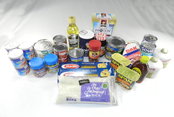
Although you probably have food in your house, it may not be sufficient if a disaster hits – especially if the power fails and everything in your refrigerator/freezer goes bad. Alternatively, you might be one of those people that plans “one last run to the supermarket” immediately prior to the storm. But what if the shelves are bare once you get there? Because of this you should have a stock of Disaster Preparedness food stored at home. It doesn’t have to be a year’s supply – but it probably needs to be enough to last you at least 3 to 7 days - 2 weeks if possible. Plan on ~2,000 calories per person, per day since that’s what the Food and Drug Administration (FDA) recommends and what the "Nutrition Facts Label" containing the percentage of the "Recommended Daily Amount (RDA)" found on food packages is based on. You should focus on storing foods high in protein first and “fillers” after that. If you want the canned food to last longer in storage - avoid foods that have tomato or barbecue sauces. Having the following types of non-perishable food to go with whatever else you have in your house, and with your other Hiking/Camping gear, will help. (Note: the amounts listed below should be enough food for a family of 4 for approximately 2 weeks - including the Mountain House freeze-dried buckets):
- Canned (remember to also have a manual can opener)
- Corned Beef Hash – 2 cans
- Spam - 2 cans
- Vienna Sausages – 6 cans
- Canned Chicken - 4 cans
- Canned Ham - 2 cans
- Tuna – 2 cans
- Canned beans - 2 cans
- Dried
- Rice - 2 pounds
- Pasta – 2 boxes
- Freeze dried (see the Camping/Cooking page for details)
- Mountain House Classic bucket
- Mountain House Breakfast bucket
- Miscellaneous Food
- Carnation Instant Nonfat Dry Milk
- Bob's Red Mill Gluten Free Egg Replacer
- OVA Easy Dehydrated Egg Crystals
- Freeze-dried Coffee
- Oatmeal
- Honey
- Jam
- Olive Oil (~20 months shelf life)
- Bouillon cubes (beef and chicken)
- Salt (no iodine)
- Extra fuel canisters for camping cook stove
You might ask why we didn’t advocate storing canned vegetables or fruits for a disaster with the other food items we listed above. Well, we didn’t put them on our 3 day to 2 week list because their dietary necessity is low in a short duration emergency (when compared to your body’s need or protein), because most people normally already have enough fresh vegetables/fruits either in their refrigerator, frozen items in their freezer, or canned items in their pantry to last for a few days, and because the stable shelf life of canned vegetables/fruits is shorter than other foods. But, if you want to plan to be self-sufficient for longer than 2 weeks, you’re going to need vegetables and fruits – both for a healthy diet and for taste variety.
So, if you already have all of the other gear on our Disaster Preparedness list, then what you need most to be self-sufficient for more than 2 weeks is additional food. However, this is a slippery slope since you then have to decide how much more food and what kinds of food to add to your 2-week supply. Short of becoming a full-blown “prepper” the best answer is to probably purchase more freeze dried meals, purchase more of the same non-perishable food items we recommended above, and augment this supply by adding some of the following canned vegetables and fruits – in quantities that support whatever duration you think is prudent – to your non-perishable food supplies:
If you want more details on the foods you should have stored in preparation for a disaster, here’s a good article on the topic from Happy Preppers: 37 Foods to Hoard: Survival food storage you can get from the grocery store
And, if you're curious about how long your disaster preparedness food will last and still be edible - and what's the best way to store it - here's a great website to help you figure that out: StillTasty.com
Note: See the Camping/Cooking and Camping/Tools pages for other items related to food, food preparation and food acquisition.
So, if you already have all of the other gear on our Disaster Preparedness list, then what you need most to be self-sufficient for more than 2 weeks is additional food. However, this is a slippery slope since you then have to decide how much more food and what kinds of food to add to your 2-week supply. Short of becoming a full-blown “prepper” the best answer is to probably purchase more freeze dried meals, purchase more of the same non-perishable food items we recommended above, and augment this supply by adding some of the following canned vegetables and fruits – in quantities that support whatever duration you think is prudent – to your non-perishable food supplies:
- Canned Vegetables (generally have a shelf life of ~3 to 5 years)
- Artichoke Hearts
- Asparagus
- Carrots (dehydrated)
- Corn
- Diced Tomatoes (shelf life of ~2 years due to its acidic nature)
- Green Beans
- Green and Chili Peppers
- Pumpkin
- Spinach
- Sweet Potatoes
- Vegetable Medley
- Yams
- Canned Fruits (generally have a shelf life of ~18 months)
- Apples
- Applesauce (like Go-Go Squeez)
- Blueberries
- Cherries
- Fruit Cocktail
- Fruit Slices (dehydrated)
- Mandarin Oranges
- Peaches
- Pears
- Pie Filling
- Pineapple
- Raspberries
If you want more details on the foods you should have stored in preparation for a disaster, here’s a good article on the topic from Happy Preppers: 37 Foods to Hoard: Survival food storage you can get from the grocery store
And, if you're curious about how long your disaster preparedness food will last and still be edible - and what's the best way to store it - here's a great website to help you figure that out: StillTasty.com
Note: See the Camping/Cooking and Camping/Tools pages for other items related to food, food preparation and food acquisition.
Personal Cleanliness Items
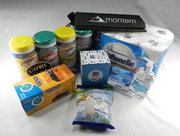
Good basic personal hygiene and cleanliness is critical to help prevent the spread of illness and disease. Good hygiene is perhaps even more important in a disaster situation such as a flood, hurricane, earthquake or disease epidemic/pandemic (like COVID-19 - the coronavirus). Normally we have clean, safe running water for proper hygiene and handwashing, but finding clean, safe running water after a disaster can sometimes be difficult. The following products will help to ensure that you have good hygiene and handwashing in the event of an emergency; with or without running water:
Note: See the Camping/Hydration and Camping/Tools pages for other items related personal cleanliness. In addition, these items should also be augmented by the everyday household cleaning supplies that you already have in your house (e.g. 409, Windex, dish washing soap, Lysol, Clorox bleach, paper towels, etc.,).
- Antibacterial Soap
- Antibacterial Hand Wipes
- Wet Ones - individually wrapped so that they stay wet during storage
- Hand Sanitizer
- Disinfecting Wipes
- Paper Towels
- Toilet Paper
- Wysi Wipes
- Compressed wipes that expand when dipped in water. You can buy Wysi Wipes at Amazon.
- Trash Bags
- Dry sacks for a spare set of clothes for each person in your family (8 to 10 liters)
- Montem Oceanum Dry Bag (10L). You can buy the Montem Oceanum Dry Bag at Amazon.
Note: See the Camping/Hydration and Camping/Tools pages for other items related personal cleanliness. In addition, these items should also be augmented by the everyday household cleaning supplies that you already have in your house (e.g. 409, Windex, dish washing soap, Lysol, Clorox bleach, paper towels, etc.,).
First Aid Kit Additions

In a disaster First Responders may not be able to get to you, you may not be able to get to the local hospitals, the hospitals may be overwhelmed if you can get there, or they may even be destroyed. Therefore you need to be prepared to perform more First Aid than you might in a usual situation. Because of this you need to add additional items to what you already have in your Hiking/Camping First Aid Kits. The following list of "home pharmacy" items recommended by WedMD will help. While you're on their website, you might also want to look over the items that WebMD thinks that you should have in your home and travel First Aid kits.
:
Note: See the Camping/First Aid and Hiking/First Aid page for other items related First Aid.
:
- Nitrile Gloves
- Clotting Agent
- Celox. You can buy Celox at Amazon.
- Burn Dressing Pads
- Cold Compresses - 10
- Certi-Cool Instant Cold Compress. You can buy Certi-Cool Compresses at CampingSurvival.com.
- Antibiotics - Since you may not be able to get antibiotics to put in your Disaster Preparedness kit from your doctor, you might want to investigate the somewhat controversial approach of purchasing fish and bird antibiotics produced by Thomas labs (or some other reputable pharmaceutical manufacturer). They’re commonly sold in human doses, are available without a prescription and are often produced on the same production lines as human antibiotics. But since they are not FDA approved for human consumption there are potentially risks. So do some research and make a decision for yourself; especially since we're not Doctors and don't dispense medical advice. If you do decide to purchase bird or fish antibiotics to store for an emergency situation, make sure that they only have the active ingredient that you are looking for (e.g. Amoxicillin) and don’t have any ingredients that will make your feathers fluffier or your scales shinier. You can buy Fish and Bird Antibiotics at CampingSurvival.com if you decide that the risks are worth it.
- Amoxicillin - 500 mg tablets
- Amoxicillin is used to treat many different types of infection caused by bacteria, such as tonsillitis, bronchitis, pneumonia, gonorrhea, and infections of the ear, nose, throat, skin, or urinary tract.
- For more information on Amoxicillin see https://www.drugs.com/amoxicillin.html
- Cephalexin - 250 mg tablets
- Cephalexin is a cephalosporin (SEF a low sporin) antibiotic. It works by fighting bacteria in your body. Cephalexin is used to treat infections caused by bacteria, including upper respiratory infections, ear infections, skin infections, and urinary tract infections.
- For more information on Cephalexin see https://www.drugs.com/cephalexin.html
- Doxycycline - 100 mg packets
- Doxycycline is a tetracycline antibiotic that fights bacteria in the body. Doxycycline is used to treat many different bacterial infections, such as acne, urinary tract infections, intestinal infections, eye infections, gonorrhea, chlamydia, periodontitis (gum disease), and others.
- For more information on Doxycycline see https://www.drugs.com/doxycycline.html
- Amoxicillin - 500 mg tablets
- Pain and Fever Medications
- Motrin (Ibuprofen) and/or Tylenol (Acetaminophen)
- Alka-Seltzer Plus Cold
- Aspercreme with Lidocaine
- Antiseptic Solutions
- Hydrogen peroxide
- Isopropyl alcohol
- Topical Antibiotics
- Anti-biotic Ointment – Bacitracin/Neomycin Sulfate/Polymyxin B Sulfate
- Hydrocortisone
- Cortizone-10
- Antifungal Medications
- Lotrimin
- Stomach and Intestinal Disorders
- Tums
- Imodium
- Antihistamines
- Benadryl
- Decongestants
- Sudafed
- Cough Medicines
- Nyquil
- Salt
- Emergency Dental Repair Kit - In a disaster you may not be able to get to a dentist, or a dentist may not be available. So, for emergencies involving your teeth, you should have at least the bare essentials for treating dental pain and injuries.
- Dr. Stahl's Emergency Dental Kit (EDK). You can buy this EDK at CampingSurvival.com
Note: See the Camping/First Aid and Hiking/First Aid page for other items related First Aid.
Respiratory Protection
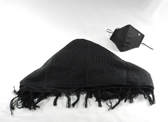
Many natural disasters have significant impacts on the air that we breathe; from increasing the amount of particulate matter in the air during a tornado or hurricane - to raising the level of mold and other harmful airborne viruses. Because of this you need to be prepared to protect your respiratory system. The following gear will help:
- Shemagh Scarf
- Explore Land 100% Cotton Shemagh Tactical Desert Scarf Wrap. You can buy this Shemagh scarf at Amazon.
- Reusable Dust Filtration Masks
- GUOER Masks - Reusable N95 - Can Be Washed. You can buy these GUOER Masks at Amazon.
Safety and Repairs
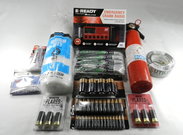
In the best case scenario you will not have to deal with any damage resulting from a disaster. But, since disasters routinely cause power outages and household damage it’s best to be prepared by stocking up on a few items to enhance your safety and your ability to perform minor repairs if necessary. The following items will help:
- Batteries
- Duracell 1.5V Coppertop Alkaline AA Batteries, 24 Pack
- Duracell 1.5V Coppertop Alkaline AAA Batteries, 16 Pack
- Duracell 1.5V Coppertop Alkaline D Batteries, 8 Pack
- Light Sticks
- Be Ready Green Glow Sticks. You can buy Be Ready Glow Sticks at Amazon.
- Crank/Battery Operated Radio
- Midland ER310 Consumer Radio – AM/FM/NOAA Weather bands, LED flashlight, Dog Whistle, USB Charger. You can buy the Midland ER310 Radio at Amazon.
- Sewing Kit
- Best Glide ASE Survival Sewing and Repair Kit. You can buy this Sewing Kit at Amazon.
- Glue
- E6000
- Duct Tape
- Plastic Sheeting/Tarps
- 10 x 25 feet – 3 mils
- Fire Extinguisher
- Signal Flares
- 12 gauge 2" Rescue and Signal Flares. You can buy these Signal flares at mightyneatstuff.com
Note: See the Camping/Tools, Camping/Light, Camping/Electronics and Hiking/Emergency Supplies pages for other items related Safety and Repairs.
Cash
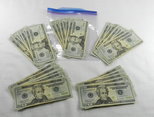
If the disaster causes either local electrical failures, or the entire electrical grid to go down, you will not be able to get money from your bank or an ATM machine, and it will not be possible for any stores to process your credit cards. Consequently, in the days immediately following the disaster, you will probably need to use cash to purchase any necessities. So you should add some cash to your Disaster Preparedness kit.
- ~$500.00 in 20-dollar bills – stored in a Ziploc bag to keep together and dry
Critical Information Packet
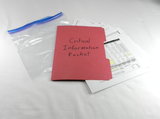
Once a disaster passes it is critical that you have the necessary information to allow you to return to your normal life as soon as possible. In many disasters your home may be damaged, or you may have had to evacuate in a hurry leaving behind all of the critical information (e.g. names, account numbers, phone numbers, etc.,) that you need to get things back on track. Because of this it’s a good idea to have a waterproof packet with all your critical information ready to go so that you can grab it when needed and refer to it later. Your Critical Information Packet should include the following:
- Personal Identification Information
- Copies of Driver’s licenses
- Copies of Passports
- Copies of Firearms Concealed Carry Licenses
- Copies of Military ID Cards (if military or ex-military)
- Insurance Information
- Home
- Personal Property
- Car
- Medical/Dental
- Life
- Utility Account Information
- Gas
- Electric
- Water
- Phone/Internet/Cable TV
- Cell Phones
- Automobile Information
- Car Titles
- Car Registrations
- House Information
- House Deed
- Property Tax Information
- Bank Accounts and Financial Information
- Business Information
- Business License
- Tax ID Information
- Key Documents
- SSN Card
- Birth Certificates
- Marriage Certificates
- DD214 (if ex-military)
- Contact List of Family, Friends and Business Associates
- Online Accounts
- Login and Password Information
Plastic Storage Bins
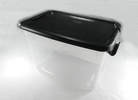
You need to keep all your Disaster Preparedness items in the same location so that you can easily find them in an emergency. You also need to make sure that these items are protected from getting too hot, too cold, or damp. The best solution is to put the items in plastic bins that have locking lids. These 30 quart Sterilite bins are a great size; big enough to store lots of random shaped items and small enough to store in out of the way spaces. We have three bins; one for the Food, one for the First Aid and Personal Cleanliness items, and one for the Safety and Repair items. Although these bins are not “watertight”, they will keep your items safe and sound while they are in storage.
|
